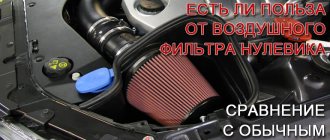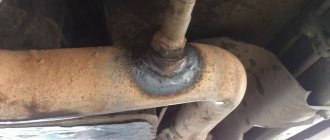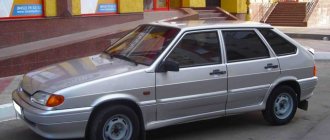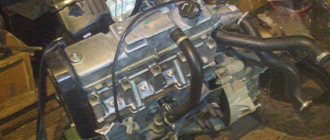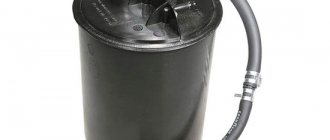Almost all car enthusiasts have a desire to increase the power and dynamics of their car. At the same time, everyone uses their own methods, based on capabilities and level of knowledge.
Some optimize the engine, others install various body kits and spoilers, others use high-quality consumables, and so on.
But experienced car owners know about another popular method - installing a zero-resistance filter.
So what is this device? What are the differences between “nulevik” and standard filters? Is there any point in spending money? Let's figure it out.
What is a zero resistance filter for and where is it used?
The task of the air filter installed in each car is to clean the flows entering the engine from various “garbage”. But this is a double-edged sword.
On the one hand, installing a filter allows you to clean the air, and on the other hand, it creates additional resistance to the flow.
The result is a decrease in power, which is especially noticeable as the filter element becomes dirty.
Zero resistance filter is an alternative to the classic filter. The main purpose is to reduce the overall air resistance without compromising the quality of cleaning.
It is believed that installing such a filter can increase engine power by an average of 5-7%. At the same time, there is almost no way to feel the difference from installation. All that remains are facts that you have to believe.
“Nuleviki” are actively used on sports cars with the same purpose - to add power to the power unit. At the same time, any alternatives are not even considered.
But it is worth considering that the difference between sports cars is not only in the installation of a special filter, but also in a more advanced exhaust system, which allows the release of large volumes of exhaust gases even at maximum speed.
WHAT MAKES NOTHING FROM
The vast majority in two ways. Some use high-quality surgical gauze as a filter element, others use porous (foamed) polyurethane. The first gauze filters appeared almost 40 years ago in the USA, since then the concept of their production has hardly changed. Porous polyurethane began to be used a little later, about 30 years ago. It is believed that this material is less demanding in maintenance and more durable. However, in the end it all depends on the operating conditions. There is also a third option, also positioned as gauze, but in fact it is a kind of artificial material, very similar to pressed padding polyester. It is quite simple to distinguish it from “medical fabric”; it does not have a pronounced mesh structure inherent in noble fabric. The actual service life of such products is short, and the quality of filtration... But we will talk about the quality of filtration in the next issues. Here we will only touch on the impregnation procedure.
How is it different from other types of filters?
The main difference between the “nulevik” lies in its design. Classic filters installed on most cars are made of paper (more precisely, from compressed fibers).
The flow of air masses passes through small holes in the fibers, and then goes to the motor.
As soon as the fibers become clogged, the resistance also increases, because the air needs to find new ways to overcome the obstacle. If you do nothing, the engine power drops.
Taking into account existing standards, the paper filter must have a large thickness with maximum fiber compression. This design ensures high-quality cleaning, but the resistance is increased immediately after installation.
The design of the “nulevik” is based on the principle of reducing resistance.
The device is based on several layers of cotton, which effectively traps dust and dirt. In this case, the retained particles essentially become part of the product.
Thanks to this, the efficiency of the filter element is higher and one square centimeter of surface accepts more dust than its predecessor.
Cotton fabric is sandwiched in an aluminum screen, which increases the filter surface. The developers claim that the working part of the “nulevik” is 4-5 times larger than in a classic filter, which ensures a long service life and lower resistance of the product.
This is achieved thanks to another factor - the presence of a special coating (oil) on the cotton, which traps dirt without harming the flow.
Why is the regular one so bad?
Low-profile tires: pros and cons
Again, everything is simple - as you and I know, an internal combustion unit has only 4 strokes, these are intake, compression, ignition, and exhaust gases. The engine, on the intake stroke, sucks the air-fuel mixture into the engine cylinders; if gasoline flows through its own line, then air is sucked in from the environment. If there were no filter, it would be sucked in with everything that came across (midges, dust, etc.), but the filter protects against this - however, it is a kind of plug that prevents the air from passing through normally, that is, resistance is encountered.
The standard filter element has a significant resistance coefficient, often taking away 5 - 7% from the engine power. This is understandable, it practically does not allow dust particles to pass through, and is made of special paper.
This element is far from ideal, it seems like everything is simple, but damn there is no solution and that’s it! Or is there?
The principle of operation of the filter, its features
The operating principle of the “nulevik” is based on two factors:
- high-quality cleaning of the flow entering the motor;
- minimum air resistance.
The effectiveness of the zero resistance filter is due to its unique design and the use of cotton (rather than paper) material.
The incoming flow is filtered from dust without causing any significant contamination to the product. Thanks to special impregnation, particles entering through the filter settle on the surface and do not interfere with the flow of air to the combustion chamber.
As a result, a sufficient volume of air enters the intake manifold, and the power of the power unit increases.
The main advantages that tuning fans highlight
Many people wonder, but not everyone knows what a zero will do with a conventional motor.
- The power of the power plant increases to 10%. This is despite the fact that there is still a filter, and particles will not get into the cylinders along with the combustible mixture.
- Nulevik does not require frequent replacement, unlike a conventional filter.
Such an air purifier, as it becomes dirty, is simply washed with a special aerosol. After treatment, the unit can be reused. A modern filter can be installed in a standard place, depending on the shape, but you can simply put it on and clamp it with a clamp on the air supply line.
Advantages and disadvantages of “nuleviks”
As practice shows, such filters have their positive and negative qualities.
Let's start with the pros:
- increase in power by 5-7%. Of course, this may not be noticeable to the driver, but when installed in combination with other types of engine tuning, the result can be felt for yourself;
- changing the sound characteristics of the motor. It is believed that the filter element makes a special sound, which changes the general hum from the engine compartment. Many car enthusiasts install “nuleviks” precisely for this reason;
- The appearance of the space under the hood changes - it becomes more sporty.
Disadvantages of "nulevik":
- the need for constant maintenance, which not all car owners like to do;
- affordable filters are of low quality, so they clog almost immediately. The oil also becomes contaminated faster, which leads to a decrease in the life of the power unit.
What to look for when choosing a cleaning component?
The range of products available on the market is very large, since the filter element in question is a consumable material. The car owner decides which company to choose based on his own convictions, since the quality of all products is at the same level. It is also worth remembering that the brand will not affect the frequency of changing consumables.
But you should still beware of low-quality products. When buying a filter, you should unpack it and check its condition. It should be made of thick pressed paper. A rubber gasket should be glued along the contour of one of the sides (additional dust protection).
How to care for such filters?
As already mentioned, one of the main disadvantages of the filter is the need for regular maintenance.
After purchasing and installing the product, it must be washed and treated regularly. In this case, processing according to the “remove-wash-install” principle will no longer work - a special algorithm is required here.
The frequency of washing is every 5-6 thousand kilometers. If the car is operated in dusty areas or off-road, then the filter must be cleaned more often.
If you forget about servicing the device, the machine becomes “gluttonous” and “dumb.”
The algorithm of actions is as follows:
- remove the zero filter from the machine and remove all dust from it using a special brush;
- Wash the unit in a special container with a special cleaning solution, then rinse the filter under water pressure;
- shake off the filter element and inspect it. If there are light spots, the filter needs to be impregnated with a special agent;
- treat the product with a special impregnation (as a rule, it is sold separately from the “nulevik”);
- return the “zero” to its original place.
There are even special kits for caring for “nuleviks”, which include washing and impregnation. A few manipulations as described above, and the product looks like new.
Please note that the total number of washes can be limited and is about 20 pieces. After this, it is worth installing a new filter.
Excellent radar detector for the money SoundQuest 420
Ceramic car coating, pros and cons
The SoundQuest 420 radar detector is suitable for car enthusiasts looking for an inexpensive and reliable device. At a cost of approximately $50, this radar detector has all the necessary characteristics:
- detects all ranges of radar systems in Russia and the CIS countries: X, Ka, K, short-pulse signals Ultra-X and K, as well as the POR range; the laser receiver detects light rays in a complete circle;
- a new system for filtering false alarms and impulses in the Ka range is preinstalled - Smart-Filter;
- protection from detection by VG-2 radar detectors.
The miniature body will not clutter up the interior, much less block the view of the road; the device is attached using suction cups and a bracket to the windshield, or glued to the front dashboard with double-sided adhesive tape. Even a novice driver can install and connect. The device operates from the car's network, the connection is made to the cigarette lighter, a 12-15 Volt adapter is included. If something is unclear, you can use the self-learning function; the radar detector will demonstrate the basic principles of operation. The kit includes detailed instructions in Russian.
Having detected a pulse from a police radar, the device will issue an individual signal corresponding to the frequency of the received wave, and an icon corresponding to the range will light up on the LED screen. As you approach the traffic police post, the intensity of the beepper will increase. If desired, you can set the signal muting mode or adjust the comfortable volume level. There are also 4 levels of display brightness.
When starting the engine, you do not have to turn on and configure the radar detector every time; all previously entered settings are saved in memory. When driving outside the city, the sensitivity level is adjusted by simply switching between City/Highway modes.
There are few reviews about the SoundQuest 420 radar detector. The advantages include a good reception range, especially outside the city. There are also a lot of disadvantages, and they are all standard: increased sensitivity to extraneous impulses, frequent malfunctions, cannot be left in the car overnight in winter - it will turn on at least half an hour after starting the engine.
ravid.ru
Installation Features
Many car enthusiasts make a big mistake - they install the “zero” incorrectly, which is why it is not able to perform its functions normally.
For example, the filter is installed too close to a hot engine or exhaust manifold. Here it’s time to remember physics.
The density of cold air is higher than that of hot air. As a result, it is easier to “push” cold air into the combustion chamber than hot air.
Therefore, the “nulevik” should be located as far as possible from any heat sources (motor, exhaust manifold, etc.).
In addition, it is not recommended to install the filter in the lower part of the engine compartment. In such a situation, the product will quickly become dirty and lose its best qualities.
In addition, a dirty filter will have to be “repaired”, which will also take some time.
Today there are a lot of models of zero filters that are designed for installation on various types of cars - with an injector or a carburetor.
The material can be mesh, foam rubber or cotton. Filters made of foam rubber have the highest degree of purification, but they also have more resistance than their “brothers”.
Installation of the “nulevik” on different cars is done differently, but in general you need to follow the following algorithm:
- discard the connector from the MAF (mass fuel flow sensor);
- use a screwdriver to disconnect the rubber tube from the air flow sensor;
- remove the sensor fasteners from the body (to do this you will have to unscrew a couple of bolts);
- dismantle the case and remove the rubber clamps (use duckbills or pliers);
- unscrew the fastener from the group of wires;
- fasten a pair of bolts from the mass air flow sensor clamp to the “zero” fastener;
- Place a new filter on the mass air flow sensor, tighten the clamping clamp and connect the sensor.
That's all, the new filter is installed on the car.
Replacing the air filter on a VAZ 2101-VAZ 2107
Note! To replace the air filter, you only need one “10” wrench and it is advisable to stock up on a clean rag in order to wipe the dirt off the inside of the air filter housing!
- Replacing the air filter
- Additional video clip
Where is the air filter located?
Immediately after opening the hood of the car, of course, you will not be able to find the air filter, but why? Yes, because it is located inside the case, which you see in the photo below. To clearly see the filter, you will first have to remove the cover of this housing and only then remove it. (For information about the procedure for removing the cover and replacing the filter, read in the same article just below)
When should you change the air filter?
- Firstly, as a rule, there is no such frequency for replacing the air filter! And all because it must be replaced if it is heavily soiled or if it is severely deformed.
- Your memory will help you understand when you need to check the filter status, but why do you ask? Yes, because if the filter is heavily contaminated, the car’s consumption increases by “0.5-1” liters, and since the classics do not have an on-board computer that measures consumption, in this case, use only your memory.
Note! Well, you still look into the engine from time to time to check the condition of the filter and replace it if necessary!
How to replace the air filter on a VAZ 2101-VAZ 2107?
Removal: 1) First, unscrew all the nuts that secure the air filter cover.
2) Then remove the cover from the air filter.
3) Next, remove the air filter from the housing.
4) And then cover the carburetor neck with a clean rag to prevent dirt from getting into it.
5) Next, wipe the inner air filter housing and covers with a rag.
Installation: 1) Install the new air filter in the reverse order of removal.
Important! 1) Make sure that no dirt gets into the carburetor neck when replacing the filter!
2) On some cars there are marks on the air filter cover, according to which the cover must be aligned:
- When the outside temperature is +5 and above, the red mark (indicated by the letter “A”) should be located near the warm air supply pipe, which is indicated by the letter “G”.
- When the outside temperature is -5 and below, the red mark should be located near the air intake pipe, which is indicated by the letter “B”.
Note! 1
If there are no such marks on the filter cover, then pay attention to the fixed damper with a seal, it replaces the red mark! (For information about where the damper with seal is located, see the very bottom of the article, in the “For Beginners!” section)
2. If there is no sealing flap on the air filter cover, then install the air filter cover as you wish!
For newbies! Question: Where is the air filter cover seal located? Answer:
Additional video: In order for you to better understand how to properly replace the air filter on a classic car, watch the added video below, after watching it you will understand everything clearly and clearly.
Vaz-Russia.ru
How to make a zero filter with your own hands?
Some car enthusiasts, in a desire to save money, decide to make a “nulevik” with their own hands.
The source is a factory round filter, which was once installed on Moskvich cars.
To make a “nulevik” you can use different methods. We will describe one of them below.
You will need available tools (foam rubber, sealant, sharp knife, glue and others). The total price of the issue is no more than 3-4 US dollars.
It’s worth noting right away that a converted “zero” is unlikely to add power to your car. The reason is outdated technologies that were used in the production of cars in the 70-80s.
When creating filters, manufacturers thought little about the importance of cleaning, so old products only retain very large pieces of dirt. So, by “creating” a zero filter, you are taking a certain risk and can “kill” your engine.
By the way, the only car where such a zero filter would be “at home” is the Moskvich. At the same time, there are owners who immediately cut off the walls to eliminate excess flow resistance.
If you decide to experiment, the sequence will be as follows:
- remove the standard device;
- Make a rectangular adapter with a hole from a piece of plywood.
Drill four more holes and fix the adapter to the air meter sensor.
Before doing this, install a piece of pipe into the hole and treat the cracks with sealant;
- Make additional holes in two plywood circles. At the same time, make a hole of a larger diameter on the outer circle, and on the inner circle (installed near the air meter) - according to the diameter of the pipe being installed. The latter shrinks using sealant;
- make 3 bars with a length of about 16-18 centimeters and use them to fasten the circles. The result will be a unique cylindrical shape. Since there is no plywood in the bars, it is necessary to make holes along the edges for installing self-tapping screws (otherwise the plywood may be damaged);
- To prevent the foam from falling out, make a body. To make it, you can take a mesh for GVL joints. The advantage is the presence of a sticky base, which allows for immediate fixation;
- then foam rubber is glued on the outside using thermosealant, which allows you to securely and quickly fix the device;
- fix a couple of pieces of foam rubber for the side of the barrel with sealant;
- put on foam rubber and fasten the plywood beams with ties.
There are simpler solutions.
We think from the first start: how to extend the life of the motor
The service life of a car largely depends on driving style and proper attitude towards the vehicle. Only in second place is the quality of manufacturing of parts and assembly of units.
From the moment you buy a car, you should already think about how to extend the life of the internal combustion engine
. The following activities will help you do this:
- the process of running in car systems should be carried out only in accordance with the modes specified by the manufacturer;
- It is advisable to keep the tachometer needle in the recommended speed range (for the “ten”: 2000 – 3500 rpm (16 v) and for 8 v: 1500 – 3000 rpm);
- do not expose the internal combustion engine to operation in the red zone, as the crankshaft bearings wear out quickly;
- refrain from using the car in winter;
- If you drive frequently in urban conditions, you should change the oil twice as often, and do not spare any money on the latter.
It is also worth remembering that it is necessary to regularly clean the fuel, oil and air filters of the VAZ 2110 vehicle systems throughout the entire period of use of the vehicle. The change interval in mileage units is indicated in the tens service instructions.
Reviews
The best indicator of the need to install such a device is reviews from real car enthusiasts. Here are some of them:
Anton, Belgorod.
“I’ve been driving with a zero car for a long time. I did the intake and exhaust at the same time, so the result was significant (like after a good engine chipping). If you install a zero filter on a regular car with normal settings, there will be no result.”
Egor, Kazan.
“I didn’t feel any effect from installing a zero filter. What can be changed by installing a piece of rag?!”
Mikhail, Smolensk.
“When you turn off the engine, there is a unique suction sound that adds to the “sportiness” of the car. I installed a “zero” on the Galant and am pleased. The car felt faster.”
But there is a point
There is a common misconception that by removing the filter and housing you can significantly increase engine power. This is completely untrue.
It is important to take into account that when developing an engine, a careful calculation of the valve timing is made, which takes into account errors and losses on the filter. And if dust starts to enter the engine, it will definitely not be able to work for a long time. Here it is necessary to have a fence that will prevent the penetration of contaminants. Resistance can be reduced by widening the passage holes. But then the quality of filtration will decrease.
Before looking for a product code and buying a zero for your motorcycle or car, remember one simple truth. For cars without a powerful sports engine, the cost of purchasing such a filter will be absolutely pointless. You will only waste several thousand rubles. The only thing you will get is a slightly changed engine sound.
Nuleviks are only suitable for sports cars and cars with powerful power plants. The use of such a filter on serial engines is allowed only in cases where a comprehensive modification is carried out. That is, boring is done in the cylinders, an enlarged throttle valve is mounted, sports camshafts are installed, etc. You can also put a zero in the kit with them.
Types of Federal Tax Service
Based on the filtering method, “zero filters” are divided into two types:
- Soaked. Currently, they are considered the most effective both in increasing engine power (up to 7%) and in air filtration efficiency. The smallest particles of dust, when in contact with the wet surface of the filter element, settle on it. For impregnation, special oil-based compositions are used. Moreover, each manufacturer of filters of this type, naturally, recommends using only liquids of their own brand.
- Dry. An increase in throughput is achieved through the use of special filter materials (mainly based on perforated polyurethane) and design features. They are less effective (compared to impregnated products) in terms of power increase (up to 5%), but are not inferior to them in terms of filtration efficiency.
According to the place of installation they are divided into:
- Mounted to replace standard filters. In terms of geometry, they completely replicate the original products.
- Mounted directly onto the intake manifold air pipe. They have the shape of a truncated cone.
